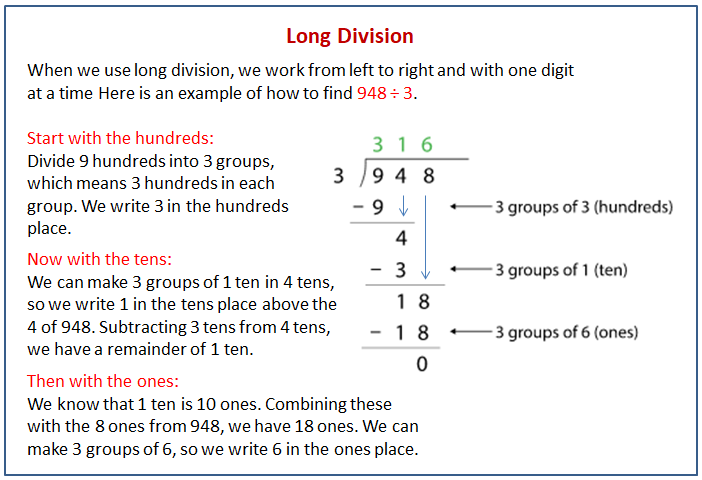Illustrative Mathematics Unit 6.5, Lesson 10: Using Long Division
Learning Targets:
- I can use long division to find a quotient of two whole numbers when the quotient is a whole number.
Related Pages
Illustrative Math
Grade 6
Lesson 10: Using Long Division
Let’s use long division.
Illustrative Math Unit 6.5, Lesson 10 (printable worksheets)
Lesson 10 Summary
Long division is another method for calculating quotients. It relies on place value to perform and record the division.
When we use long division, we work from left to right and with one digit at a time, starting with the leftmost digit of the dividend. We remove the largest group possible each time, using the placement of the digit to indicate the size of each group.
The following diagram shows how to use long division.

Lesson 10.1 Number Talk: Estimating Quotients
Estimate these quotients mentally.
500 ÷ 3.
1,394 ÷ 9
Lesson 10.2 Lin Uses Long Division
Lin has a method of calculating quotients that is different from Elena’s method and Andre’s method. Here is how she found the quotient of 657 ÷ 3:
- Discuss with your partner how Lin’s method is similar to and different from drawing base-ten diagrams or using the partial quotients method.
- Lin subtracted 3 · 2 then 3 · 1, and lastly 3 · 9. Earlier, Andre subtracted 3 · 200 then 3 · 10, and lastly 3 · 9. Why did they have the same quotient?
- In the third step, why do you think Lin wrote the 7 next to the remainder of 2 rather than adding 7 and 2 to get 9?
- Lin’s method is called long division. Use this method to find the following quotients. Check your answer by multiplying it by the divisor.
a. 846 ÷ 3
b. 1,816 ÷ 4
c. 768 ÷ 12
Lesson 10.3 Dividing Whole Numbers
- Find each quotient.
a. 633 ÷ 3
b. 1001 ÷ 7 - Here is Priya’s calculation of 906 ÷ 3
a. Priya wrote 320 for the value of 906 ÷ 3. Check her answer by multiplying it by 3. What product do you get and what does it tell you about Priya’s answer? b. Describe Priya’s mistake, then show the correct calculation and answer.
Lesson 10 Practice Problems
- Kiran is using long division to find 623 ÷ 7
He starts by dividing 62 by 7. In which decimal place should Kiran place the first digit of the quotient (8)?
A. Hundreds
B. Tens
C. Ones
D. Tenths - Here is a long-division calculation of 917 ÷ 7.
a. There is a 7 under the 9 of 917. What does this 7 represent?
b. What does the subtraction of 7 from 9 mean?
c. Why is a 1 written next to the 2 from 9 - 7? - Han’s calculation of 972 ÷ 9 is shown here.
a. Find 180 · 9.
b. Use your calculation of 180 · 9 to explain how you know Han has made a mistake.
c. Identify and correct Han’s mistake. - Find each quotient.
- One ounce of a yogurt contains of 1.2 grams of sugar. How many grams of sugar are in 14.25 ounces of yogurt?
A. 0.171 grams
B. 1.71 grams
C. 17.1 grams
D. 171 grams - The mass of one coin is 16.718 grams. The mass of a second coin is 27.22 grams. How much greater is the mass of the second coin than the first? Show your reasoning.
The Open Up Resources math curriculum is free to download from the Open Up Resources website and is also available from Illustrative Mathematics.
Try out our new and fun Fraction Concoction Game.
Add and subtract fractions to make exciting fraction concoctions following a recipe. There are four levels of difficulty: Easy, medium, hard and insane. Practice the basics of fraction addition and subtraction or challenge yourself with the insane level.

We welcome your feedback, comments and questions about this site or page. Please submit your feedback or enquiries via our Feedback page.